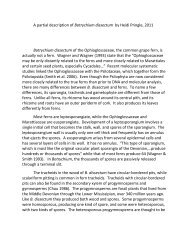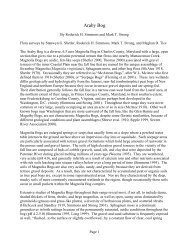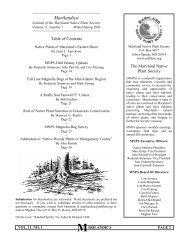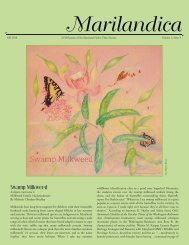Wildflower in Focus - Maryland Native Plant Society
Wildflower in Focus - Maryland Native Plant Society
Wildflower in Focus - Maryland Native Plant Society
Create successful ePaper yourself
Turn your PDF publications into a flip-book with our unique Google optimized e-Paper software.
eflect<strong>in</strong>g the traditional medical uses of milkweeds.<br />
Steven Foster and James A. Duke (Peterson Field<br />
Guides: Eastern/Central Medic<strong>in</strong>al <strong>Plant</strong>s) report:<br />
Swamp milkweed “root tea [is] diuretic, carm<strong>in</strong>ative,<br />
strongly laxative; <strong>in</strong>duces vomit<strong>in</strong>g. American<br />
colonists used it for asthma, rheumatism, syphilis,<br />
worms, and as a heart tonic. Warn<strong>in</strong>g: Potentially<br />
toxic.” <strong>Maryland</strong> <strong>Native</strong> <strong>Plant</strong> <strong>Society</strong> board member,<br />
master gardener and weed warrior Marney Bruce<br />
(founder of Simplicity Matters Earth Institute) says<br />
that author Timothy Coffey “writes that Pueblo<br />
Indians cut it down when ripe, rub it so as to separate<br />
the fibers, and make of it beautiful and very strong<br />
fish<strong>in</strong>g l<strong>in</strong>es and f<strong>in</strong>e sew<strong>in</strong>g-thread. He notes that<br />
early botanists remarked at how tough and strong the<br />
stem is.” When I queried a few members and friends<br />
of the <strong>Maryland</strong> <strong>Native</strong> <strong>Plant</strong> <strong>Society</strong> about swamp<br />
milkweed and milkweeds <strong>in</strong> general I discovered a<br />
wide-spread and deep fasc<strong>in</strong>ation for this genus. Dr.<br />
Edward M. Barrows, biology professor at Georgetown<br />
University and director of the Georgetown University<br />
Center for the Environment, shared many wonderful<br />
milkweed stories and this is my favorite: “When I was<br />
on Oahu, Hawaii <strong>in</strong> 1976 dur<strong>in</strong>g a lovely November<br />
day with an ocean breeze, I was amazed to see giant<br />
milkweed shoots which were about 10 feet tall<br />
grow<strong>in</strong>g <strong>in</strong> a garden.” Dr. Barrows noted: “This plant<br />
might have been Calotropis procera=Asclepias<br />
procera, Giant Milkweed, native to West Africa<br />
through India.” He went on to say: “I had to rub my<br />
eyes to make sure I wasn’t dream<strong>in</strong>g <strong>in</strong> Rousseau<br />
Land…The plants looked like giant, mutant Asclepias<br />
syriaca to me, and it seemed like the Mean Giant<br />
might descend on them at any moment look<strong>in</strong>g for<br />
children to eat. I saw normal-sized Monarchs nectar<strong>in</strong>g<br />
on the flowers. Both species are aliens on Oahu—a<br />
poor, hapless island under water <strong>in</strong> aliens.”<br />
Similar Species: More than a dozen milkweeds are<br />
<strong>in</strong>digenous to <strong>Maryland</strong>. Deep rose-p<strong>in</strong>k corollas<br />
and moist habitats are the best means of separat<strong>in</strong>g<br />
swamp milkweed plants from other locally<br />
<strong>in</strong>digenous species.<br />
Bloom<strong>in</strong>g Time: June - August.<br />
Fruit<strong>in</strong>g Time: Fruits mature and split open dur<strong>in</strong>g<br />
summer and autumn.<br />
Locations: Common throughout <strong>Maryland</strong>.<br />
Montgomery County forest ecologist and MNPS board<br />
member Carole Bergmann writes: “I have seen<br />
Asclepias <strong>in</strong>carnata <strong>in</strong> Rachel Carson Conservation<br />
Park, Little Bennett Regional Park, Black Hill<br />
Regional Park, Dickerson Conservation Park, Rock<br />
Creek SVP, Serpent<strong>in</strong>e Conservation Park to name a<br />
few. Also on County property along the Blue Mash<br />
Trail near the Laytonsville Landfill. Its color and<br />
flower shape really appeal to me, and so I am always<br />
happy to spot it.” As for other Asclepias <strong>in</strong> the county<br />
park system, that she has seen, Carole lists “A.<br />
purpurascens <strong>in</strong> Serpent<strong>in</strong>e Conservation Park, Little<br />
Bennett Regional Park, and <strong>in</strong> the field across from<br />
Hoyles Mill park where gentians are; A. verticillata <strong>in</strong><br />
Serpent<strong>in</strong>e Conservation Park and Hoyles Mill<br />
Conservation Park; A.viridiflora also <strong>in</strong> Serpent<strong>in</strong>e<br />
Conservation Park, Hoyles Mill Conservation Park,<br />
and Lois Green Conservation Park; A. tuberosa – a lot<br />
at Little Bennett Conservation Park and, of course, A.<br />
syriaca <strong>in</strong> many many many parks!”<br />
Karyn Mol<strong>in</strong>es, supervisor of cultural resources for the<br />
Anne Arundel County Department of Parks and<br />
Recreation and MNPS board member, sees swamp<br />
milkweed at Jug Bay Wetlands Sanctuary, where she<br />
also f<strong>in</strong>ds A. tuberosa, A. syriaca, and A.<br />
amplexicaulis. Author, educator and MNPS board<br />
member Cris Flem<strong>in</strong>g f<strong>in</strong>ds A. <strong>in</strong>carnata at Hughes<br />
Hollow <strong>in</strong> the McKee-Beshers WMA. Consult F<strong>in</strong>d<strong>in</strong>g<br />
<strong>Wildflower</strong>s <strong>in</strong> the Wash<strong>in</strong>gton-Baltimore Area<br />
(Flem<strong>in</strong>g, Lobste<strong>in</strong> and Tufty) for more swamp<br />
milkweed locations.<br />
Many members and friends of the <strong>Maryland</strong> <strong>Native</strong><br />
<strong>Plant</strong> <strong>Society</strong> contributed to this article, <strong>in</strong>clud<strong>in</strong>g:<br />
Alonso Abugattas, Carole Bergmann, Edward M.<br />
Barrows, Marney Bruce, Pat Durk<strong>in</strong>, Cris Flem<strong>in</strong>g,<br />
Wesley M. Knapp, Karyn Mol<strong>in</strong>es, and Rod Simmons.<br />
Thank you to everyone who contributed!









